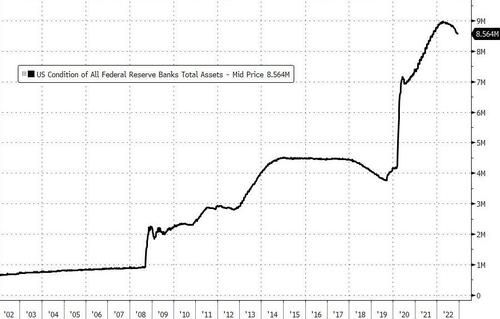Most people have focused on Federal Reserve interest rate cuts as it battles price inflation. But there is another element in the inflation fight most people ignore – balance sheet reduction.
It isn’t going well.
The December FOMC statement mentioned balance sheet reduction in passing.
The Committee will continue reducing its holdings of Treasury securities and agency debt and agency mortgage-backed securities, as described in the Plans for Reducing the Size of the Federal Reserve’s Balance Sheet that were issued in May.”
The problem with this statement is it isn’t following the plan described in May.
The plan called for $30 billion in US Treasuries and $17.5 billion in mortgage-backed securities to roll off the balance sheet in June, July and August. That would total $45 billion per month. In September, the Fed said it would increase the pace to $95 billion per month.
Given the plan, the Fed balance sheet should have dropped by $560 billion as of the end of December. According to the latest data, as of Dec. 19, the balance sheet had only shrunk by $401 billion.
That means unless there is a significant drop in the last week of the year, balance sheet reduction is nearly $160 billion behind the planned pace.
This raises a question: if the Fed is really committed to slaying inflation, why is it shrinking its balance sheet so slowly?
The question becomes more poignant when you realize that the quantitative tightening plan wasn’t particularly ambitious to begin with. At $95 billion per month, it would take 7.8 years for the Fed to shrink its balance sheet back to pre-pandemic levels.
And that’s how you slay inflation.
Historical Perspective
In the wake of the 2008 financial crisis, the Federal Reserve ran three rounds of quantitative easing, pushing the balance sheet from $8.98 billion to just over $4.5 trillion. The central bank tried to reduce the balance sheet in 2018, but quickly reversed course after the stock market crashed and the economy got wobbly in the fall of that year. At its low point, the balance sheet dipped just below $3.76 trillion.
The Fed had already returned to quantitative easing before the coronavirus, and the balance sheet was back above $4 trillion in October 2019. QE went on steroids during the pandemic, with the balance sheet peaking at $8.965 trillion on April 11, 2022.
In effect, between 2008 and 2022, the Fed injected nearly $8 trillion in money created out of thin air into the economy.
Coupled with artificially low interest rates, all of this money creation predictably drove the price inflation we’re seeing today. The problem is that rate cuts alone won’t unwind inflation. All of the new money created over the last decade-plus needs to be pulled out of the economy.
Since the Fed waded into its inflation fight, the balance sheet has only shrunk by a relatively tepid 4.5%.
This isn’t adequate.
In fact, the Fed’s quantitative tightening hasn’t reduced the money supply at all. While we have seen a few months of monetary contraction, M2 growth for 2022 is currently flatlined at zero. That’s certainly an improvement over the massive money supply expansion we saw during the pandemic, but it isn’t going to put the brakes on price inflation. It will just slow it down, which is exactly what we’re seeing in the CPI data.
But while the slowdown in money creation isn’t enough to bring inflation to the mythical 2% target, it is significant enough to pop a bubble economy addicted to easy money. As SchiffGold’s analyst put it, “The Fed may be confident in their rate hikes and the resiliency of the economy, but they are playing with serious fire. They have put the entire economy at serious risk of a major event as the liquidity has dried up extremely fast.”
[ZH: Perhaps this is the real reason why... US stock market cap is falling almost tick for tick with Reserve balances...]
The bottom line is that while the Fed talks a good game about its commitment to reining in inflation, its actions don’t line up with its rhetoric, especially when it comes to reducing the size of its bloated balance sheet.
And again – this calls into question the Fed’s commitment to fighting inflation. If the central bank truly viewed inflation as “public enemy No. 1” and believed the economy is strong enough to handle tighter monetary policy, why isn’t it aggressively reducing its balance sheet?


No comments:
Post a Comment
Note: Only a member of this blog may post a comment.